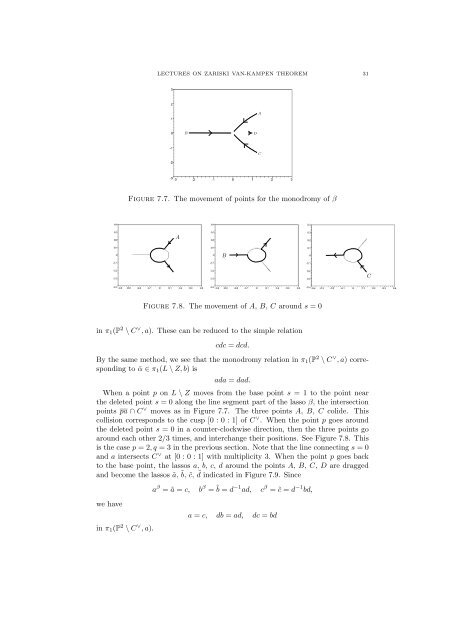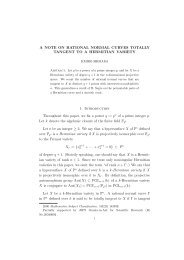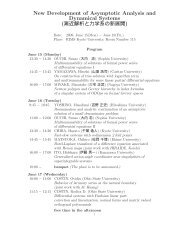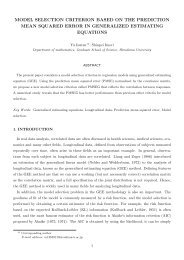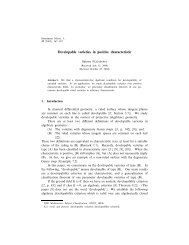LECTURES ON ZARISKI VAN-KAMPEN THEOREM 1. Introduction ...
LECTURES ON ZARISKI VAN-KAMPEN THEOREM 1. Introduction ...
LECTURES ON ZARISKI VAN-KAMPEN THEOREM 1. Introduction ...
Create successful ePaper yourself
Turn your PDF publications into a flip-book with our unique Google optimized e-Paper software.
<strong>LECTURES</strong> <strong>ON</strong> <strong>ZARISKI</strong> <strong>VAN</strong>-<strong>KAMPEN</strong> <strong>THEOREM</strong> 31<br />
A<br />
B<br />
D<br />
C<br />
Figure 7.7. The movement of points for the monodromy of β<br />
A<br />
B<br />
C<br />
Figure 7.8. The movement of A, B, C around s =0<br />
in π 1 (P 2 \ C ∨ ,a). These can be reduced to the simple relation<br />
cdc = dcd.<br />
By the same method, we see that the monodromy relation in π 1 (P 2 \ C ∨ ,a) corresponding<br />
to ᾱ ∈ π 1 (L \ Z, b) is<br />
ada = dad.<br />
When a point p on L \ Z moves from the base point s = 1 to the point near<br />
the deleted point s = 0 along the line segment part of the lasso β, the intersection<br />
points pa ∩ C ∨ moves as in Figure 7.7. The three points A, B, C colide. This<br />
collision corresponds to the cusp [0 :0:1]ofC ∨ . When the point p goes around<br />
the deleted point s = 0 in a counter-clockwise direction, then the three points go<br />
around each other 2/3 times, and interchange their positions. See Figure 7.8. This<br />
is the case p =2,q = 3 in the previous section. Note that the line connecting s =0<br />
and a intersects C ∨ at[0:0:1]with multiplicity 3. When the point p goes back<br />
to the base point, the lassos a, b, c, d around the points A, B, C, D are dragged<br />
and become the lassos ã, ˜b, ˜c, ˜d indicated in Figure 7.9. Since<br />
a β =ã = c, b β = ˜b = d −1 ad, c β =˜c = d −1 bd,<br />
we have<br />
in π 1 (P 2 \ C ∨ ,a).<br />
a = c, db = ad, dc = bd


